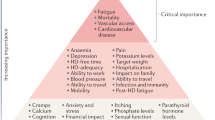Abstract
Background
A home haemodialysis programme (HHD) was established in Ireland in 2009 following studies suggesting better outcomes and a survival advantage when compared to conventional in-centre dialysis.
Aim
The aim of this study was to assess the outcomes in patients commenced on the HHD programme.
Methods
Baseline characteristics, standard dialysis parameters, blood pressure control, antihypertensive usage, vascular access problems, hospitalisation rates and technical issues related to dialysis were analysed.
Results
Seventeen patients were followed over a 2-year period. Time spent travelling for dialysis-related treatments was reduced with time on dialysis per week increased. There was a trend towards lower blood pressure with nine patients, either discontinuing or having a reduction in antihypertensive medications. There were eight episodes of hospitalisation with the majority of complications related to vascular access.
Conclusion
Home haemodialysis is a community-based therapy, offering an alternative to conventional in-centre haemodialysis in a select patient population.


Similar content being viewed by others
References
Merrill JP, Schupak E, Cameron E, Hampers CL (1964) Hemodialysis in the home. JAMA 190:468–470
Hampers CL, Merrill J (1966) Hemodialysis in the home—13 months’ experience. Ann Intern Med 64(2):276–283
Eschbach JW Jr, Barnett BM, Cole JJ, Daly S, Scribner BH (1967) Hemodialysis in the home: a new approach to the treatment of chronic uremia. Ann Intern Med 67(6):1149–1162
Roberts JL (1976) Analysis and outcome of 1,063 patients trained for home hemodialysis. Kidney Int 9(4):363–374
Mailloux LU, Kapikian N, Napolitano B et al (1996) Home hemodialysis: patient outcomes during a 24-year period of time from 1970 through 1993. Adv Ren Replace Ther 3(2):112
Delano BG, Friedman EA (1990) Correlates of decade-long technique survival on home hemodialysis. ASAIO Trans. 36(3):M337–M339
Mowatt G, Vale L, Perez J et al (2003) Systematic review of the effectiveness and cost-effectiveness, and economic evaluation, of home versus hospital or satellite unit haemodialysis for people with end-stage renal failure. Health Technol Assess 7(2):1–174
McGregor DO, Buttimore AL, Lynn KL (2000) Home hemodialysis: excellent survival at less cost, but still underutilized. Kidney Int 57(6):2654–2655
Evans RW, Manninen DL, Garrison LP Jr et al (1985) The quality of life of patients with end-stage renal disease. N Engl J Med 312(9):553–559
US Renal Data System (2010) USRDS 2008 Annual data report: Atlas of chronic kidney disease and end-stage renal disease in the United States. National Institute of Diabetes and Digestive and Kidney Diseases, Bethesda
Fagugli RM, Reboldi G, Quintaliani G et al (2001) Short daily haemodialysis: blood pressure control and left ventricular mass reduction in hypertensive haemodialysis patients. Am J Kidney Dis 38:371–376
Woods John D, Port Friedrich K, Stannard David et al (1996) Comparison of mortality with home haemodialysis and centerhemodialysis: a national study. Kidney Int 49:1464–1470
F O’Brien (2011) Arterio-venous fistula buttonhole cannulation technique: a retrospective review of infectious complications Irish Nephrology Society. http://www.era-edta.org/images/INS_2011_Short%20_Program.pdf
The National Renal Office (2011) Epidemiology of ESKD in adults in Ireland.http://www.hse.ie/eng/about/Who/NRO/census.pdf
Ting GO, Kjellstrand C, Freitas T, Carrie BJ, Zarghamee S (2003) Long-term study of high-comorbidity ESRD patients converted from conventional to short daily hemodialysis. Am J Kidney Dis 42(5):1020–1035
FHN Trial Group, Chertow GM et al (2010) In-center hemodialysis six times per week versus three times per week. N Engl J Med 363(24):2287–2300
Van Eps CL, Jones M, Ng T, Johnson DW et al (2010) The impact of extended-hours home hemodialysis and buttonhole cannulation technique on hospitalization rates for septic events related to dialysis access. Hemodial Int. 14(4):451–463
Diamant MJ, Harwood L, Movva S et al (2010) A comparison of quality of life and travel-related factors between in-center and satellite-based hemodialysis patients. Clin J Am Soc Nephrol. 5(2):268–274
Conflict of interest
None.
Author information
Authors and Affiliations
Corresponding author
Rights and permissions
About this article
Cite this article
Connaughton, D.M., Jamal, A., McWilliams, J. et al. Home haemodialysis in Ireland. Ir J Med Sci 182, 91–96 (2013). https://doi.org/10.1007/s11845-012-0835-4
Received:
Accepted:
Published:
Issue Date:
DOI: https://doi.org/10.1007/s11845-012-0835-4




